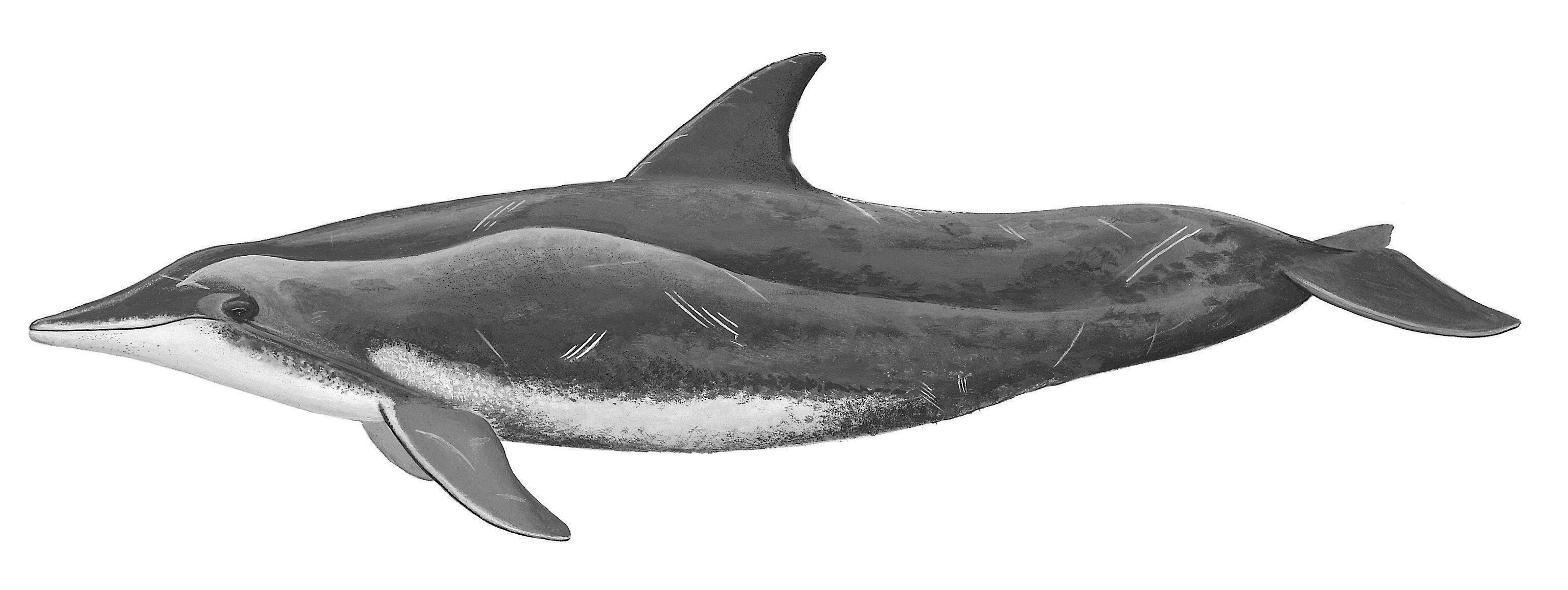ROUGH-TOOTHED DOLPHIN
Steno bredanensis (Lesson 1828)
Order Cetacea : Family Delphinidae
DESCRIPTION. A small, grayish-black dolphin with the forehead rising gradually from the beak; 20–27 fairly large teeth in each tooth row, the crowns of which have many fine, vertical wrinkles (thus, the name "rough-toothed"); length of rostrum about three times its width. Total length, 2–2.7 m. Weight, 100–135 kg.

DISTRIBUTION. Rough-toothed dolphins occur in tropical and warm temperate waters around the world. In the western North Atlantic, they are sparsely distributed from Virginia to the northeastern coast of South America. Although this species is not very common in the Gulf of Mexico, it occurs there at any time of the year. It is known in Texas on the basis of two historical strandings near Galveston and four more in the recent stranding record (2002–2014) from three counties (Kleberg, Brazoria, and Kenedy).
SUBSPECIES. Monotypic species.
HABITS. Little is known about the life history of these dolphins. They occasionally travel in groups of 50 or more, but smaller groups are normal. They are probably good echolocators and are easily trained.
A mass stranding of these dolphins occurred on the upper Gulf coast of Florida in May 1961. Sixteen of them ran aground in a shallow, marshy area, but the cause was never determined.
Food habits are almost unknown. They are known to eat octopus, squid, and fish. Nothing is known about their reproductive habits; in captivity, they have mated with bottlenose dolphins and produced hybrid offspring.
POPULATION STATUS. Uncommon; strandings and observations. There are many recorded strandings of the rough-toothed dolphin on the beaches of the Gulf of Mexico, including Texas, where it was first observed in late June 1969. These are generally offshore, deepwater dolphins, and there are no reliable population estimates, which makes it difficult to predict its overall status accurately. Stranding and sighting records in the Gulf of Mexico are from all seasons, and it is likely that rough-toothed dolphins occur there year-round. During the GulfCet surveys, they were also sighted in all seasons. Group sizes averaged about 10 animals, with a range of 2–48. Abundance in the northern Gulf of Mexico is estimated at about 500 animals but could be considerably higher.
CONSERVATION STATUS. The IUCN lists the rough-toothed dolphin in the least concern category because the species is widespread and abundant and there have been no reported population declines or major threats identified. Likewise, the species is not listed by the USFWS, but for no apparent reason, other than perhaps rarity in the stranding record, TPWD lists it as threatened.
From The Mammals of Texas, Seventh Edition by David J. Schmidly and Robert D. Bradley, copyright © 1994, 2004, 2016. Courtesy of the University of Texas Press.
Natural Science Research Laboratory
-
Address
Museum of Texas Tech University, 3301 4th street, Lubbock, TX 79409 -
Phone
806.742.2486 -
Email
nsrl.museum@ttu.edu

